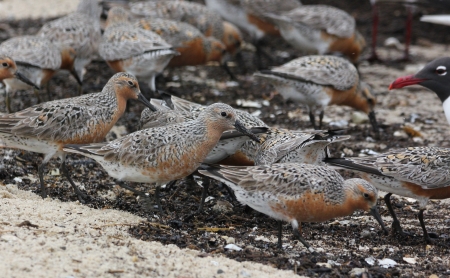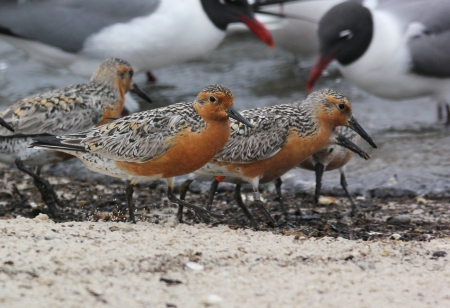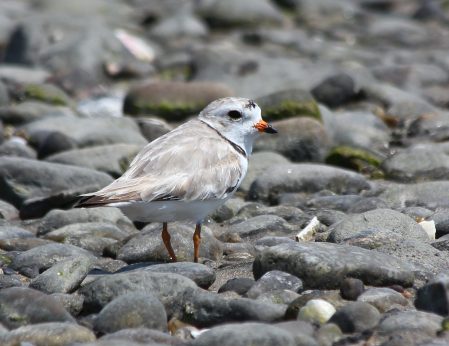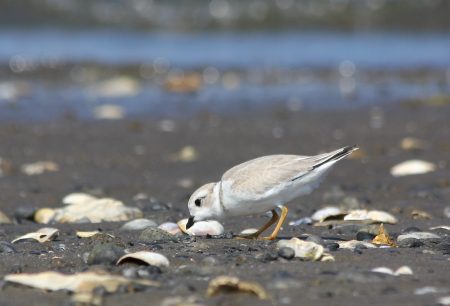
Red Knots, Reed’s Beach
Cape May, New Jersey. Reed’s Beach. Morning. Under an overcast late May sky, the surf rises and falls gently with the incoming tide, drawn up the sand by an ancient, inexorable force. It carries the scent and taste of the sea and pushes before it the raucous chorus of a multitude of winged voices: the cries of gulls, the scolding of terns, and the peeps and chatters of many hundreds of shorebirds. For the second time in my life, I’ve traveled 300 miles from home to bear witness to one of North America’s great avian spectacles: the annual procession of shorebirds through Delaware Bay. Turnstones, Dunlins, Willets, Least and Semipalmated Sandpipers, all descend on the bay to feed and gather strength before making the final push to their summer homes. All are delightful, every one a thrill to see. But there’s one bird here who surpasses all others, whose arrival is as eagerly awaited as the return of a long-traveling lover, and whose reappearance on these sandy shores each year is cause for grand celebration. Spring migration has just kicked into high gear; the Red Knots have returned.
I fell in love with Red Knots two years ago, on my first pilgrimage to Reed’s Beach. It was a trip I’d been meaning to take for some time, but in a typical year I only get to Cape May once, for fall raptor migration (something for which Cape May is justifiably famous). As a group, shorebirds have long been one of my favorites, though. There’s something particularly engaging in watching them work the beach, probing the wet sand enthusiastically for a meal, skittering away from the surf and back again with each succession of waves, legs moving in double-time. They seem to truly enjoy life; only a cold heart could fail to be charmed by them. But among these wonderful birds, Red Knots are extraordinary. Cast in deep russet from face through belly, backs and wings elegantly patterned in black, white, and tan, they are exquisite. Watching hundreds of these gorgeous sandpipers move along the sand eagerly devouring horseshoe crab eggs was spellbinding, and I was captivated.
When talking about Red Knots, it’s common to speak in superlatives. This is, after all, a bird that travels from pole to pole twice a year, a round-trip distance of some 18,000 miles (one of the longest migrations in the animal kingdom)—often in non-stop stretches of 1,500 miles or more. When they hit the Delaware Bay, they’re nearly starved. But their timing is impeccable: with precision that puts a Swiss watchmaker to shame, they arrive at the peak of the spawning of horseshoe crabs—upon whose eggs the knots double their weight, ensuring that they have the reserves to finish their epic journey to breeding grounds in the high Arctic.

Red Knots, Reed’s Beach
As I sat watching these birds, I thought about that journey—the vast distance, the critical timing, the reliance on a singular food source. North America’s Red Knots face a litany of threats, among them overfishing of horseshoe crabs and loss of habitat through both development and the ravages of a changing climate. So much could go wrong, could push an already struggling bird over the edge. And yet here they were, still hanging on. For how much longer was anyone guess, but for the moment I could let the future be and simply enjoy my time in their company.
Though I could easily have spent the balance of the day with the knots, I eventually took my leave of them, thanking the birds for including me, however briefly, in their lives. I wished them Godspeed and we went our separate ways. With luck, we’d meet on this beach again next year.
Closer to home, on the northeast coast of Massachusetts, rests another haven that, over the course of a year, gives shelter to a great panoply of avian life: Parker River National Wildlife Refuge. Waterfowl, marsh birds, alcids, songbirds, raptors, shorebirds… wherever they come from, whatever they are, all who reach the refuge find succor and sustenance. A few months before my visit with the knots, I’d taken a trip to Parker River with a group of friends and family. It’s a favorite spot of ours, and venturing here at the uneasy junction of winter and spring has become a tradition.

Piping Plover, Milford Point
The day had grown late and we were scanning the ocean for sea ducks when seven tiny white birds flew in low across the sand, set down on the beach and began the busy work of securing dinner. We shifted to the new arrivals, and drew in a collective breath as we brought them into focus. These were not the Sanderlings we expected, but a much rarer bird, one that engenders love at first sight, and which holds a special place in my heart. To the delight of all, the season’s first Piping Plovers had just dropped in.
Over the years, I’ve spent countless hours with these wonderful plovers, and they never fail to charm me—but as with the most rewarding relationships, their appeal lies in more than just the physical. True, they are beautiful birds, and their plump little bodies and namesake piping calls make them almost impossibly endearing. But it’s their spirit, their irrepressible joie de vivre, that moves me. Faced with threats as great as those of the Red Knot—and perhaps greater, for the Piping Plover is at once equally beloved and reviled—they steadfastly embrace life, refusing to go quietly into the dark. That they provoke such hatred is heartbreaking, but alas they live where we play, and there are those of us unwilling to set aside our wants and desires for the greater good of these imperiled birds. A sad state of affairs indeed. And yet the plovers, like the knots, are still with us, and there are many who value them and who both desire and work for their survival.

Juv. Piping Plover, Milford Point
As the sun set behind us, we took our final looks and I bid the plovers a silent farewell. I reminded myself that this was just the beginning: several months from now, on beaches up and down the coast, the next generation of plovers will emerge and take their first steps into their new world. What they’ll find is up to us.
Red Knots and Piping Plovers are bound by shared calamity, linked by the unkindest of threads: we conducted their descent to the edge of oblivion. Through our actions—and perhaps more accurately our inactions—we are engineering their doom. Their conjoined fate is in our hands.
But perhaps that’s a good thing. If we can bring about their destruction, could we not vouchsafe their survival? We are the only species that can bring about another’s extinction, but we’re also the only ones who can pull it out of the abyss. Perhaps that is our true function, our reason for being. And perhaps I continue to seek these birds out not just out of love, but because they embody hope. As long as we can still find Red Knots and Piping Plovers, all is not lost. Seeing them each year is, for me, a renewal, another chance. It closes another year in which we did not lose these wonderful birds, and brings a new opportunity for their protection, and for a wider understanding of what those who love them already know: the loss of either the knots or the plovers would drain a little more color from the world, would cast us a little farther into shadow.
There is still time. All the Red Knots and Piping Plovers ask is that we allow them space to live. If we can find it in our hearts to make room them, then there is, perhaps, a chance—for them and for us. Our folly or our wisdom will be written in their fates. For myself, I hold fast to hope, and to a vision of future beaches alive with these marvelous, spectacular birds.

Piping Plovers, Parker River NWR
This post originally appeared in the Wader Quest newsletter. Wader Quest is a U.K.-based organization dedicated to shorebird conservation (shorebirds are known as waders in the U.K.) and public education. You can learn more about Wader Quest and the work they do (and also support their efforts) at their website here.
You can learn more about Red Knots at the U.S. Fish and Wildlife Service’s Red Knot page here.
And for more info about Piping Plovers, you can check out Audubon’s page on the Piping Plovers here.
